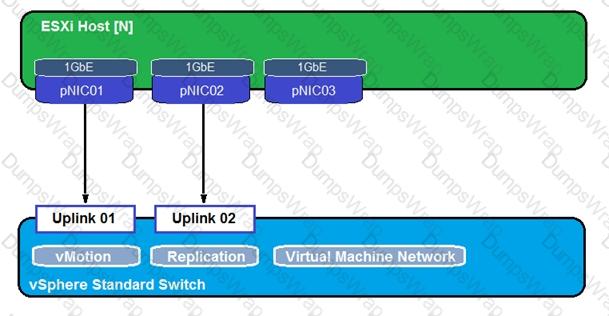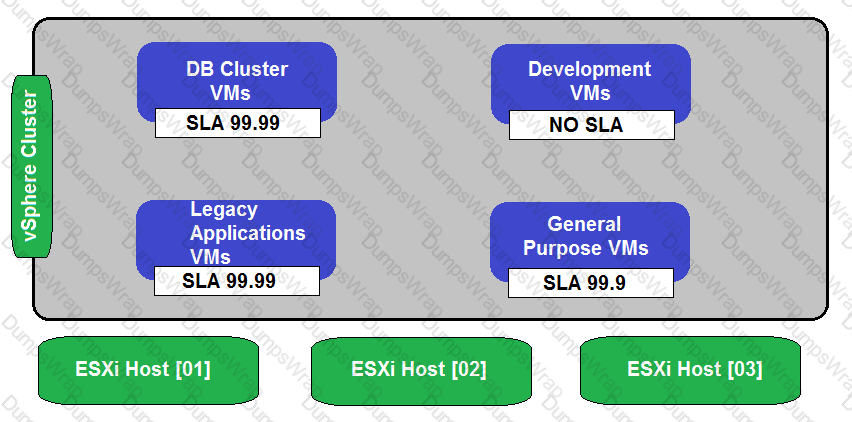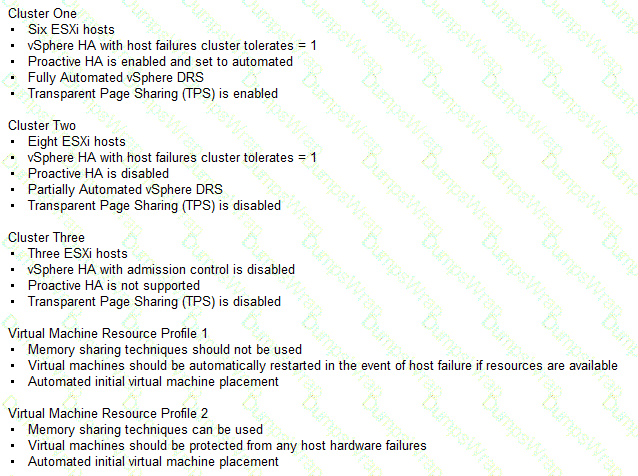Advanced Design VMware vSphere 7.x Questions and Answers
What is a benefit of using a scale-out method for handling vSphere cluster growth?
Following a company merger, there are two data centers running vSphere environments. Both data centers are leveraging separate Layer 3 vMotion networks.
Which requirement must be met in order to enable vMotion migration between these locations?
An architect is tasked with designing a new VMware software-defined data center (SDDC) solution for an online retail customer who has a primary and secondary data center as well as 10 distribution hubs.
The customer has provided the following business requirements to help inform the design:
- The solution must support the running of up to 1,000 concurrent virtual machines across the primary and secondary data center.
- The solution must support the running of up to 20 concurrent virtual machines in each distribution hub.
- The solution must support the separation of management and lines-of-business application virtual machines.
- All management components (including directory services, backup, automation, operations and logging) must be deployed to the primary data center.
- All virtual infrastructure components must have redundancy of N+1.
- All sites are connected to each other using a wide area network that has multiple diversely routed links.
- The solution should support a monthly uptime target of 99.9%.
- The recovery time objective (RTO) for the solution must be four hours.
- The recovery point objective (RPO) for the solution must be 24 hours.
Given the information from the customer, which assumption should the architect include in the design?
An architect is planning the physical server configuration for a vSAN-based infrastructure.
Which operations mode should a RAID controller support to minimize potential server downtime during physical disk failures?
A new vSphere platform is being created. The platform will host virtual machines that will run management services and line-of-business applications.
What should the architect consider when designing the number and type of clusters required?
During a requirements gathering workshop to design a physical to virtual migration, the customer provides the following information:
- There is no physical firewall in the data center with no anticipated plans for a future network refresh.
- Leveraging the virtual infrastructure to mitigate the lack of network security must be addressed in the design.
- All physical servers to be migrated exist on the same VLAN.
Which recommendation should the architect make to address the customer requirement with regard to virtual networking?
An architect is designing storage for a new vSphere environment to meet the following requirements:
- Asynchronous replication is required between two sites.
- The impact on the storage layer should not impact the performance of the compute layer.
- Each application tier will require different replication attributes.
- Virtual machine live migration across compute and storage must be supported.
- Virtual machine aware back up will be leveraged.
- Operational management overhead should be minimized.
- Operational automation should be supported.
Which storage design recommendations would meet the requirements?
An architect is designing a new vSphere environment with the following resources:
- 600 vCPU
- 5,760 GB RAM
Average resource usage is:
- 60 vCPU
- 1,152 GB RAM
The design must meet the following requirements:
- The environment has the ability to burst by 25%.
- Each host can schedule 36 vCPUs and has 512 GB RAM.
- Management overhead is 20%.
What is the minimum number of hosts required to meet the design requirements?
In a meeting to discuss the minimum viable product (MVP) deployment of a new customer-facing application, the key stakeholder shares details of the application components and the application administrators share details of performance and integrity tests for the application.
The application will be made up of the following components:
- A web server
-Steps to confirm the web server is operating correctly will take 15 minutes after the application server is online.
- An application server
-Steps to confirm application server integrity will take 15 minutes after the database is online.
- A database server
-The database server will be managed by a database administrator, with an agreed service-level agreement (SLA) to restore and validate database services within one hour.
The existing VMware infrastructure offers a recovery point objective (RPO) of 5 minutes and recovery time objective (RTO) of 15 minutes through a combination of backups and replication.
In the event of an outage impacting all three application components, how long will it take for the application to recover and complete all checks?
An architect is designing a VMware solution for a customer based on the following information:
- The solution must use investments in existing storage array that supports both block and file storage.
- The solution must support the ability to migrate workloads between hosts within a cluster.
- The solution must support resource management priorities.
- The solution must support the ability to connect virtual machines directly to LUNs.
- The solution should use existing IPv4 based network infrastructure.
- There is no budget for additional physical hardware.
Which two design decisions could the architect make to meet these requirements? (Choose two.)
Following a recent acquisition, an architect needs to merge IT assets into its current data center. The combined vSphere environment will need to run the newly acquired company’s virtual machines.
Network integration work has already been completed and the current environment has capacity to host all virtual machines. The Operations team needs to identify which virtual machines belong to the acquired company and report on their usage.
How should the architect merge the company’s assets and virtual machines?
An architect is tasked with designing a greenfield VMware software-defined data center (SDDC) solution that will be used to deliver a private cloud service for a customer.
During the initial meeting with the service owner and business sponsor, the customer has provided the following information to help inform the design:
- The solution must support the concurrent running of 1,000 virtual machines
- The production environment must be delivered across two geographically dispersed data centers All virtual machines must be capable of running in either data center.
- The two data centers are currently connected to each other through a single but diversely routed, high bandwidth and low latency link.
- The link between the two data centers is capable of supporting a round-trip time (RTT) of 150 ms The existing server hardware standard document states that all virtual infrastructure hosts must be deployed using vSAN ReadyNodes
- The service owner has stated that it is critical to ensure the availability target of 99.9% All virtual machine backups must be completed using the existing backup service
- The recovery time objective (RTO) for the service is five minutes
- The recovery point objective (RPO) of the service is four hours
Which two elements represent risks to the successful delivery of this solution? (Choose two.)
Refer to the exhibit.

During a requirements gathering workshop, the customer shares the following about their existing ESXi host virtual networking infrastructure:
The customer confirms that:
- Each ESXi host has approximately 200 virtual machines.
- They want to maximize the number of concurrent virtual machine migrations.
- When placing a host in maintenance mode, it takes a long time to evacuate the virtual machines.
Which two recommendations should the architect make in order to help the customer overcome their challenge? (Choose two.)
An architect is designing a solution based on the following information:
- Each ESXi host has a single physical NIC with two 10 Gbps ports.
- There is a performance-based service-level agreement (SLA) that guarantees 15 Gbps bandwidth for production virtual machines at all times.
- There is no budget to purchase additional hardware.
- The hardware replacement SLA is based on a delivery agreement of two business days.
Which recommendation for the configuration of vSphere High Availability (HA) should the architect include in the design?
Refer to the exhibit.
During a requirements gathering workshop, the customer shares the following diagram regarding their availability service-level agreements (SLAs):

The customer wants database application level availability to always take precedence. What should the architect recommend to meet the customer’s requirement?
As part of a new hybrid cloud initiative for a large financial company, the customer technical team is presenting an overview of the current state of the infrastructure and their vision for a new solution.
The project team captures notes during the presentation and adds them to the discovery documentation. Which of the listed statements is a design constraint?
During a requirements gathering workshop, the customer provides the following information:
- Each host has 2 × 10 GbE NIC
- EtherChannel is not currently configured
- No changes can be made to the physical network
- Network throughput must be prioritized for defined critical services
Which two recommendations should the architect make with regard to virtual networking? (Choose two.)
An architect is preparing a design for a company planning digital transformation. During the requirements gathering workshop, the following requirements (REQ) and constraints (CON) are identified:
- REQ01 The platform must host different types of workloads including applications that must be compliant with internal security standard.
- REQ02 The infrastructure must initially run 100 virtual machines.
- REQ03 Ten of the virtual machines must be compliant with internal security standard.
- REQ04 The internal security standard specifies logical network separation for in-scope applications.
- CON01 The customer has already purchased the licenses as part of another project.
- CON02 The customer has five physical servers that must be reused.
Additionally, based on resource requirements, four physical servers will be enough to run all workloads. Which recommendation should the architect make to meet requirements while minimizing project costs?
An architect is considering placement of virtual machines within an existing VMware software-defined data center (SDDC).
During the discovery phase, the following information is documented:

Which two recommendations should the architect make for placement of the virtual machines to meet resource profile requirements? (Choose two.)
An architect is designing a VMware software-defined data center (SDDC) solution based on the following customer requirements:
- The solution must initially support 1,000 virtual machines
- The solution must scale to support the concurrent running of up to 5,000 virtual machines
- The production environment should be delivered across two data centers
- The solution should have a maximum tolerable downtime (MTD) of four hours
- The solution should have a monthly service availability target of 99.8%
Which two assumptions could the architect make based on the information from the customer to help size the solution? (Choose two.)
During a requirements gathering workshop, the customer’s Chief Information Security Office (CISO) provides the following requirements that are pertinent to the design of a new vSphere environment:
- All operating system critical patches must be installed within 24 hours of release.
- All virtual machine templates must be updated every three months in line with company policy.
Which requirement classification is being gathered for the design documentation?
A customer provides the following list of requirements for their vSphere platform:
- REQ01 The solution should utilize dual network connections to eliminate single points of failure.
- REQ02 The solution should allow logs to be retained for a period of 30 days.
- REQ03 All user access to the platform should be recorded for audit purposes.
- REQ04 The solution should allow the management of multiple ESXi hosts.
- REQ05 The solution should allow users to view the remote console of virtual machines.
Which two of the listed requirements would be classified as non-functional requirements? (Choose two.)
An architect is considering placement of virtual machines within an existing VMware software-defined data center (SDDC).
During the discovery phase, the following information is documented:
Cluster One
- Six ESXi hosts
- vSphere HA with host failures cluster tolerates = 1
- Proactive HA is enabled and set to automated
- Fully Automated vSphere DRS
- Transparent Page Sharing (TPS) is enabled
Cluster Two
- Eight ESXi hosts
- vSphere HA with host failures cluster tolerates = 1
- Proactive HA is disabled
- Partially Automated vSphere DRS
- Transparent Page Sharing (TPS) is disabled
Cluster Three
- Three ESXi hosts
- vSphere HA with admission control is disabled
- Proactive HA is not supported
- Transparent Page Sharing (TPS) is disabled
Virtual Machine Resource Profile 1
- Memory sharing techniques should not be used
- Virtual machines should be automatically restarted in the event of host failure if resources are available
- Automated initial virtual machine placement
Virtual Machine Resource Profile 2
- Memory sharing techniques should not be used
- Virtual machines should be automatically restarted in the event of host failure regardless of available resources
- Automated initial virtual machine placement
Which two recommendations should the architect make for placement of the virtual machines to meet resource profile requirements? (Choose two.)
An architect is designing a new vSphere environment to meet the following requirements:
- The environment must support 5,000 virtual machines.
- The environment will be built initially using 350 hosts.
Which vCenter Server appliance deployment size should the architect specify for the design?
During a requirements gathering workshop, the customer provides the following requirement (REQ) and constraints (CON):
- REQ01: The customer is looking for a way to limit database virtual machine (VM) placement to save on CPU licensing costs.
- CON01: There is a single cluster with no budget to scale.
- CON02: All virtual machines must run on the consolidated cluster.
Which two design decisions should the architect make to meet the customer requirement? (Choose two.)
An architect is tasked with recommending a solution for a company that is running out of VLANs. Currently the company is running two separate data centers based on vSphere including an Enterprise Plus license. In the first data center, the problem was solved by using VMware NSX and overlay network. In the second data center, there is currently no VMware NSX implementation in place and no budget for additional licenses.
What should the architect recommend as a potential solution to provide support for additional VLANs?

